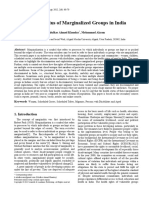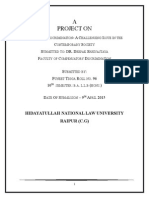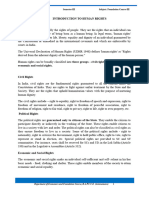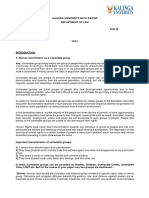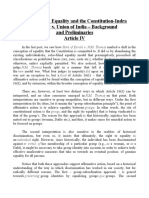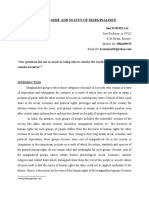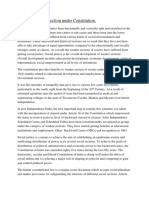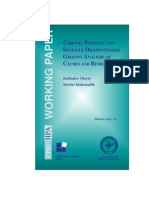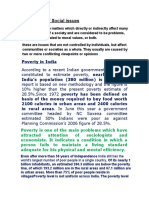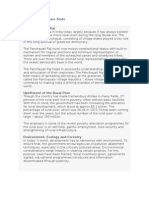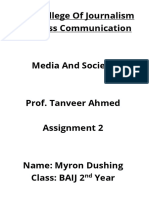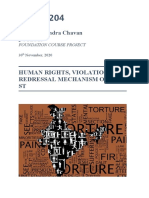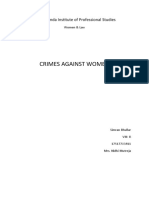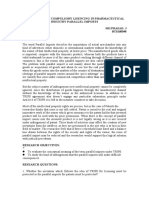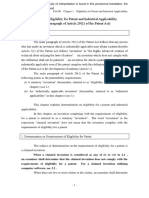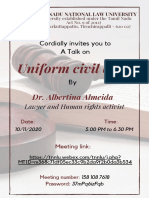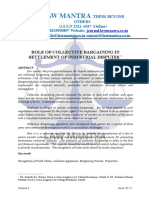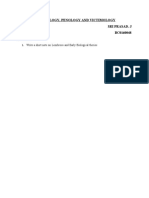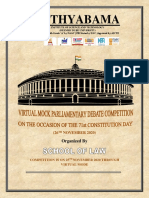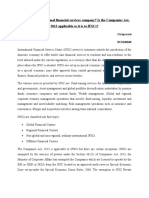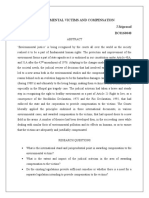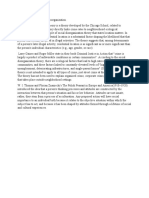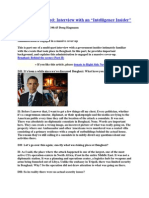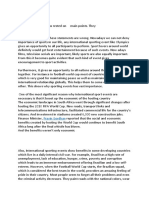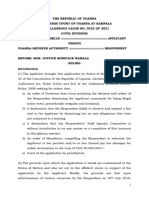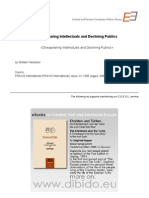Crimes against Vulnerable groups in India and
Procedural Error under Cr. P. C.
Sriprasad.J
BC0160048
Vulnerable groups are the groups which would be vulnerable under any circumstances (e.g.
where the adults are unable to provide an adequate livelihood for the household for reasons of
disability, illness, age or some other characteristic), and groups whose resource endowment is
inadequate to provide sufficient income from any available source. In India there are multiple
socio-economic disadvantages that members of particular groups experience which limits
their access to health and healthcare. The task of identifying the vulnerable groups is not an
easy one. Besides there are multiple and complex factors of vulnerability with different layers
and more often than once it cannot be analysed in isolation. The present document is based
on some of the prominent factors on the basis of which individuals or members of groups are
discriminated in India, i.e., structural factors, age, disability and discrimination that act as
barriers to health and healthcare. The vulnerable groups that face discrimination include-
Women, Scheduled Castes (SC), Scheduled Tribes (ST), Children, Aged, Disabled, Poor
migrants, People living with HIV/AIDS and Sexual Minorities. Sometimes each group faces
multiple barriers due to their multiple identities.
SCs/STs
Due to the caste system prevailing in India, the sudras have been exploited for the ages. They
were denied the right to education and thus were left languishing behind, socially and
economically. Such people have been categorized into Scheduled Castes. Tribal
communities, who never mixed with the main society, are similarly challenged and are
categorized into Scheduled Tribes.
Backward Classes
The constitution does not define the term backward classes. It is up to the centre and the
states to specify the classes that belong to this group. However, it is understood that classes
that are not represented adequately in the services of the state can be termed backward
classes. Further, the President can, under Art. 340, can constitute a commission to investigate
the condition of socially and educationally backward classes. Based on this report, the
�president may specify the backward classes. Structural norms are attached to the different
relationships between the subordinate and the dominant group in every society. A group’s
status may for example, be determined on the basis of gender, ethnic origin, skin colour, etc.
The norms act as structural barriers giving rise to various forms of inequality. Access to
health and healthcare for the subordinate groups is reduced due to the structural barriers. In
India, members of gender, caste, class, and ethnic identity experience structural
discrimination that impact their health and access to healthcare. Women face double
discrimination being members of specific caste, class or ethnic group apart from experiencing
gendered vulnerabilities. Women have low status as compared to men in Indian society. They
have little control on the resources and on important decisions related to their lives. In India,
early marriage and childbearing affects women’s health adversely. About 28 per cent of girls
in India, get married below the legal age and experience pregnancy (Reproductive and Child
Health – District level Household Survey 2002-04, August 2006). These have serious
repercussions on the health of women. Maternal mortality is very high in India. The average
maternal mortality ratio at the national level is 540 deaths per 100,000 live births (National
Family Health Survey-2, 2000). It varies between states and regions, i.e., rural-urban. The
rural MMR (Maternal Mortality Rate) is 617 deaths of women age between 15-49 years per
one lakh live births as compared to 267 maternal deaths per one lakh live births among the
urban population (National Family Health Survey-2, 2000). In most cases the deaths occur
from preventable causes. A large proportion of women is reported to have received no
antenatal care. In India, institutional delivery is lowest among women from the lower
economic class as against those from the higher class. A major proportion of the lower castes
and Dalits are still dependent on others for their livelihood. Dalits does not refer to a caste but
suggests a group who are in a state of oppression, social disability and who are helpless and
poor. They were earlier referred as ‘untouchables’ mainly due to their low occupations i.e.,
cobbler, scavenger, sweeper.7 In a caste-dominated country like India, Dalits who comprises
more than one-sixth of the Indian population (160 million approx.), stand as a community
whose human rights have been severely violated. Literacy rates among Dalits are only about
24 per cent. They have meagre purchasing power; have poor housing conditions; lack or have
low access to resources and entitlements. In rural India they are landless poor agricultural
labourers attached to rich landowners from generations or poor casual labourers doing all
kinds of available work. In the city they are the urban poor employed as wage labourers at
several work sites, beggars, vendors, small service providers, domestic help, etc., living in
slums and other temporary shelters without any kind of social security. The members of these
�groups face systemic violence in the form of denial of access to land, good housing,
education and employment. Structural discrimination against these groups takes place in the
form of physical, psychological, emotional and cultural abuse which receives legitimacy from
the social structure and the social system. Physical segregation of their settlements is
common in the villages forcing them to live in the most unhygienic and inhabitable
conditions. All these factors affect their health status, access to healthcare, and quality of
health service received. There are high rates of malnutrition reported among the marginalized
groups resulting in mortality, morbidity and anaemia. Access to and utilization of healthcare
among the marginalized groups is influenced by their socio-economic status within the
society.
Need for development of the weaker sections – the SCs STs OBCs and Minorities
The SCs STs OBCs and Minorities, have been forced to remain as the Weaker Sections of
India, and the Women confined or oppressed to be the most and multiply exploited sections
of the Country, for nearly four millenniums. This bad situation, cannot and should not
continue anymore. Definitely not in the Twenty-first Century of the third millennium, in an
age of fast travel and mass communication. There is a need for the Government to do
something special and tangible, to free and liberate the Weaker Sections, from the cobwebs of
oppression, marginalisation and backwardness. They have to be uplifted to the levels of
normal human-beings of the World.
Art. 15(4) : Clause 4 of article 15 is the fountain head of all provisions regarding
compensatory discrimination for SCs/STs. This clause was added in the first amendment to
the constitution in 1951 after the SC judgement in the case of Champakam Dorairajan vs.
State of Madras. It says thus, "Nothing in this article or in article 29(2) shall prevent the state
from making any provisions for the advancement of any socially and economically backward
classes of citizens or for Scheduled Castes and Scheduled Tribes." This clause started the era
of reservations in India. In the case of Balaji vs. State of Mysore, the SC held that reservation
cannot be more than 50%. Further, that Art. 15(4) talks about backward classes and not
backward castes thus caste is not the only criterion for backwardness and other criteria must
also be considered.
Finally, in the case of Indra Sawhney vs. Union of India, SC upheld the decision given under
Balaji vs. State of Mysore that reservation should not exceed 50% except only in special
circumstances. It further held that it is valid to sub-categorize the reservation between
�backward and more backward classes. However, total should still not exceed 50%. It also
held that the carry forward rule is valid as long as reservation does not exceed 50%.
Art. 40: Provides reservation in 1/3 seats in Panchayats to SC/ST.
Art. 46: Enjoins the states to promote with care the educational and economic interests of the
weaker sections, especially SC and STs.
Art. 164: Appoint special minister for tribal welfare in the states of MP, Bihar, and Orissa.
Art. 275: Allows special grant in aids to states for tribal welfare.
Art. 330/332: Allows reservation of seats for SC/ST in the parliament as well as in state
legislatures.
Art. 335: Allows relaxation in qualifying marks for admission in educational institutes or
promotions for SCs/STs.
In the case of State of MP vs. Nivedita Jain, SC held that complete relaxation of qualifying
marks for SCs/STs in Pre-Medical Examinations for admission to medical colleges is valid.
Art. 338/338A/339: Establishes a National Commission of SCs and STs. Art. 339 allows the
central govt. to direct states to implement and execute plans for the betterment of SC/STs.
Art. 340: Allows the president to appoint a commission to investigate the condition of
socially and economically backward classes and table the report in the parliament.
STREET CHILDREN AND ORPHANS
Street children are those for whom the street more than their family has become their real
home, a situation in which there is no protection, supervision, or direction from responsible
adults. Human Rights Watch estimates that approximately 18 million children live or work on
the streets of India. Majority of these children are involved in crime, prostitution, gang
related violence and drug trafficking. India is the world’s largest democracy with a
population of over a billion-400 million of which are children. Approximately 26% of the
Indian population lives below the poverty line and 72 % live in rural areas. Even though the
percentage of the Indian population infected with HIV/AIDS is 0.9%, (5) it has the second
largest number of people infected with HIV/AIDS in the world, the first being South Africa.
Despite the many recorded gains in the recent past, issues such as gender inequity, poverty,
illiteracy and the lack of basic infrastructure play an important role in hindering HIV/ AIDS
�prevention and treatment programs in India. The impact of the AIDS crisis has not begun to
fully emerge in India and AIDS related orphaning has not been documented. In Constitution
of India, entry 24 in list III of Schedule IV deals with the “Welfare of Labour, including
conditions of work, provident funds, liability for workmen’s compensations, invalidity and
Old age pension and maternity benefits.
MIGRANTS
Internal migration of poor labourers has also been on the rise in India. The poor migrants
usually end up as casual labourers within the informal sector. This population is at high risk
for diseases and faces reduced access to health services. In India, 14.4 million people
migrated within the country for work purposes either to cities or areas with higher expected
economic gains during the 2001 census period. Lakh number of migrants are employed in
cultivation and plantations, brick-kilns, quarries, construction sites and fish processing
(NCRL, 2001). Large numbers of migrants also work in the urban informal manufacturing
construction, services or transport sectors and are employed as casual labourers, head loaders,
rickshaw pullers and hawkers. The rapid change of residence due to the casual nature of work
excludes them from the preventive care and their working conditions in the informal work
arrangements in the city debars them from access to adequate curative care. In India, there are
a large number of international women migrants. Female migration to India constitutes 48 per
cent of the total immigration from other countries. Among the migrants who are vulnerable,
the Internally Displaced People (IDPs) deserve mention. In India, the Internally Displaced
People are estimated to be around 6 lakhs (IDMC, 2006). Internal displacement arises out of
ethnic conflicts, religious conflicts, political reasons, development projects, natural disaster
etc. The Internally Displaced People are vulnerable to access government social security
schemes. The Inter-State Migrant Workmen (Regulation of Employment and Conditions of
Service) Act, 1979 - An Act to regulate the employment of inter-State migrant workmen and
to provide for their conditions of service and for matters connected therewith.
SEXUAL MINORITIES
Another group that faces stigma and discrimination are the sexual minorities. Those
identified as gay, lesbian, transgender, bisexual, kothi and hijra, experience various forms of
discrimination within the society and the health system. Due to the dominance of
heteronomous sexual relations as the only form of normal acceptable relations within the
society, individuals who are identified as having same-sex sexual preferences are ridiculed
�and ostracized by their own family and are left with very limited support structures and
networks of community that provide them conditions of care and support. Their needs and
concerns are excluded from the various health policies and programmes. Only the National
AIDS Prevention and Control Policy recognize sexual minority and homosexuals in the
context of identifying ‘high risk behaviour’. But pervasive discrimination from the health
providers delays or deters their health seeking. Hence they remain excluded from the process
of government surveillance carried among the high risk population in the context of
HIV/AIDS. The surveillance amongst ‘MSM’ or men who have sex with men, is usually
carried out by NGOs and through ‘support groups’, i.e. amongst males who are accessible to
NGOs and who are willing to identify with categories, such as kothi, around which support
groups are structured. They also undergo considerable amount of psychological stress.
CONCLUSION
In the Constitution of India, the three pillars of human rights are (a) the right to equality
including the prohibition of discrimination in any form, (b) the six vital freedoms of citizens
(including the right to speech and expression) and (c) the right to life guaranteed to all
persons. These rights have been recognized to be inalienable, unalterable and part of the basic
structure of the Constitution which cannot be abrogated. India’s Supreme Court has
interpreted the right to life as including the right to live with dignity, right to health,
education, human environment, speedy trial and privacy, to name a few. Much of the focus of
governmental activity has been to improve the provision of services through grass-roots local
self-governance institutions, particularly in rural areas. India has taken an important initiative
for the empowerment of women by reserving one-third of all seats for women in urban and
local self-government, bringing over one million women at the grassroots level into political
decision making. India has guaranteed human rights to all persons in India including the
protection of minorities. India has secured their right to practice and preserve their religious
and cultural beliefs as a part of the Chapter on Fundamental Rights. Legislative and executive
measures have been taken for the effective implementation of safeguards provided under the
Constitution for the protection of the interests of minorities. India has been deeply conscious
of the need to empower the Scheduled Castes and Scheduled Tribes and is fully committed to
tackle any discrimination against them at every level. The Constitution of India abolished
“untouchability” and forbids its practice in any form. There are also explicit and elaborate
legal and administrative provisions to address caste-based discrimination in the country. India
stated that at independence, after the departure of the colonizers, all the people, including its
�tribal people, were considered as indigenous to India. This position has been clarified on
various occasions, including while extending India’s support to the adoption of the United
Nations Declaration on the Rights of Indigenous Peoples at the Human Rights Council and
the General Assembly.






